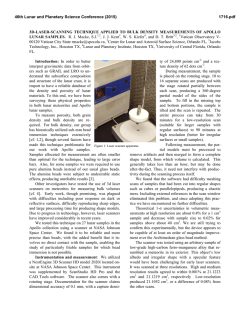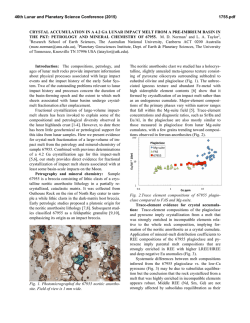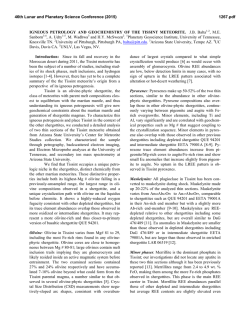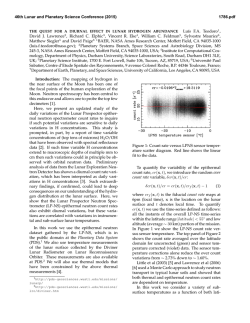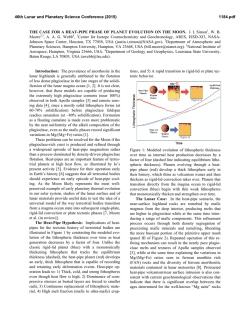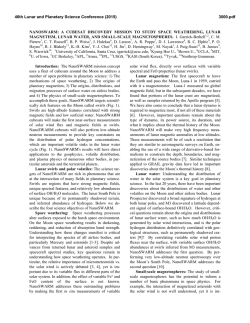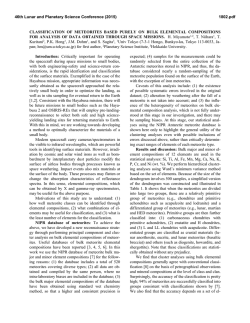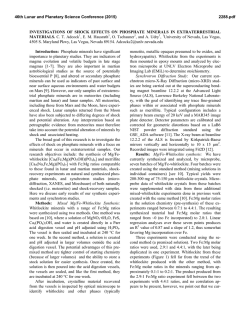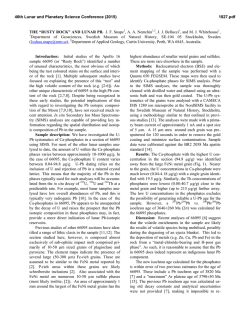
Synthesis of “large” pigeonite crystals for Lunar Spectroscopic and
46th Lunar and Planetary Science Conference (2015) 1494.pdf Synthesis of “large” pigeonite crystals for Lunar Spectroscopic and Space Weathering Studies A. Sinclair,1 D. H. Lindsley,1 H. Nekvasil,1, and T. Glotch. 1Stony Brook University, Dept. of Geosciences, Earth and Space Science Building, Stony Brook, NY 11794. [email protected]. Introduction: Apollo and Luna samples as well as the lunar meteorites have provided invaluable information on the nature of mineral phases expected to be found on the Moon and potentially on other airless bodies. Detecting such minerals by remote sensing (using for example, infrared (IR) spectroscopy) requires well characterized mineral standards. Obtaining such standards is particularly challenging if a mineral abundant on such planetary bodies cannot be readily found on Earth, commonly undergoes changes (e.g., exsolution), or is found on Earth only over a limited compositional range. Pigeonite has been described in a variety of Apollo samples, from those of the Apollo 12 pigeonite basalt suite [1] to samples from the Apollo 14 (e.g., [2]) and 15 landing sites (e.g., [3]). Pigeonite has also been reported in lunar meteorites (e.g., NWA 4936 [4] and 4884 [5]) . These occurrences suggest that pigeonite is common in lithologies on the lunar surface and the ability to identify it remotely is important. Unfortunately, terrestrial pigeonite suitable for optical standards is not readily available. Pigeonite is stable only at elevated temperature. Under conditions of slow cooling (as in plutonic rocks) it readily exsolves to form two pyroxenes: high-Ca (augite) and low-Ca (either clinohypersthene or Opx). For these reasons, pure pigeonite on Earth is almost exclusively limited to relatively finegrained volcanic rocks (and is thus, difficult to separate). Original pigeonite in coarser-grained plutonic rocks, has almost universally “inverted”, that is, it has exsolved to intergrowths of augite lamellae in a low-Ca (usually Opx) host. In order to address the need for pigeonite standards we have launched a concerted effort to synthesize pigeonites for the planetary science community. The intent is to synthesize the pigeonites within their hightemperature stability field and then quickly cool them far below their breakdown/inversion temperatures. Done properly, this should yield a single phase (at least at the X-ray diffraction level) that is metastable with respect to two pyroxenes. Experimental goals: Most natural pigeonites have calcium contents close to 10% (Wo10), but with varying ratios of Fe/ (Fe + Mg). Our synthesis program focuses on the range of pigeonite compositions (Ca0.1 ((Mg1xFex) 0.9)2Si2O6 where x = 0.60, 0.40, 0.30, and 0.20. These compositions are shown by the orange symbols in Fig. 1. A synthesis technique was sought that produces crystallites of these compositions with dimension between 30 to 100 μm, making them for suitable for a variety of infrared spectroscopic studies. Figure 1. Target compositions of synthetic pigeonites (orange circles) superimposed upon the 1 atm pyroxene stability diagram of [6], with regions of low pressure pigeonite stability at various temperatures shaded in yellow. Experimental Method: Stoichiometric mixes were prepared from dried CaSiO3, MgO, Fe2O3, SiO2, and “Fe-sponge”. The first four reagents were ground together for 2 hrs under ethanol in an agate mortar. Following this initial grinding, Fe-sponge, sufficient to convert all Fe2O3 to FeO, was added and homogenized by minimal amounts of additional grinding. These powders were first pre-reacted, which helps minimize the amount of unreacted starting material that could become trapped within the synthesized pyroxene [7]. Pre-reaction took place by loading each mix into an Ag foil “capsule” that had been loaded into a silica glass tube. Prior to sealing the tube, the samples were dried at 800° C under vacuum, (with a Fe-sponge “getter” to prevent oxidation) at ~600° C for 20 minutes to remove any moisture or residual ethanol from grinding. The tubes were then sealed while still under vacuum. These ampules were heated in a horizontal tube furnace at ~900° C for two weeks for this pre-reaction step. After pre-reaction, the material was packed into Fecapsules with tight-fitting lids, which were then inserted into silica glass tubes. The tubes were dried (with “getter”), evacuated, and sealed again, producing glass ampules. Because the thermal stability of pigeonite depends strongly on Fe/ (Fe+Mg) (see Fig. 1; also Fig. 6 in [8]), each composition was subjected to different thermal synthesis conditions for the final synthesis. Initially we attempted the final synthesis in the solid state, that is, at temperatures just below the solidus. These experiments yielded good pigeonites, but the grain size (<= 30 microns) was smaller than desired. 46th Lunar and Planetary Science Conference (2015) To increase grain size, we heated the samples to between 50-20° C above the solidus temperature (Fig. 2) for 30 min. and then slowly (at approximately 1°C/hr) cooled them to just below the solidus temperature. The samples were held at this temperature for 3-5 days and then quenched in air. Temperature conditions for each composition are shown in Table 1. Figure. 2. Solidus diagram (mol %) from [9] with target compositions indicated. P marks primary phasefield for pigeonite; AP shows primary phase field of augite plus pigeonite. Target Composition Wo10En36Fs54 Wo10En54Fs36 Wo10En63Fs27 Wo10En72Fs18 (Ca0.1Mg0.36Fe0.54)2Si2O6 (Ca0.1Mg0.54Fe0.36)2Si2O6 (Ca0.1Mg0.63Fe0.27)2Si2O6 (Ca0.1Mg0.72Fe0.18)2Si2O6 Initial T (°C) Xlln 1230 1270 1330 1370 1180 1250 1280 1330 T (°C) Table 1. Target compositions, with initial (supersolidus) temperatures and final crystallization temperatures. Synthesis results: All syntheses yielded sintered grey powders with individual grain sizes up to >100 microns in long dimension. Microscopic observations in index oil show only pyroxene with minor amounts of metallic Fe from the capsules. Powder X-ray diffraction patterns (Cu, Kα source) index to the monoclinic space group P21/c, as shown in Fig. 3. a and β values depend largely on Ca (Wo) content, whereas b mainly reflects Fe/ (Fe+Mg) [7]. Sharp peaks for (150) show little or no zoning in Fe/ (Fe+Mg); and sharp peaks for (220), (311), and (310) likewise show minimal zoning of the pigeonite in Ca; and the peak positions fit well with the target compositions. However, weak shoulders at lower 2-theta on (220), (311), and (310) suggest the presence of minor (<<10%) amounts of higher-Ca augite in all samples. We conclude that the Wo10 compositions for these samples probably fell just within the pigeonite + augite (AP) field of [9] at some stage during their synthesis; note that all compositions fall very close to the boundary between the P and AP fields of Fig. 2. We 1494.pdf plan to repeat the syntheses at very slightly lower Wo contents. Figure. 3. Powder diffraction pattern for Wo10En54Fs36 in red. Black reflection markers for monoclinic space group P21/c with lattice parameters a = 9.732(1) Å, b = 8.931(1) Å, c = 5.2485(7) Å and β = 108.583(7)°. Acknowledgements: This work was supported by the RIS4E program, a SSERVI science team. References: [1] Meyer, C. (2011) Lunar Sci. Compendium. [2] James, O.B. (1973) Geol. Soc Prof. Paper 841. [3] Bouquain, S. & Arndt, N.T. (2006) Geophy. Res. Abstr. 00624. [4] meteorites.wustl.edu/lunar/stones/nwa4936.htm. [5] meteorites.wustl.edu/lunar/stones/nwa4884.htm. [6] Lindsley, D.H. (1983) Am. Min. 68, 477. [7] Turnock, A., Lindsley, D.H., Grover, J.E. (1973) Am. Min. 58, 50 [8] Davidson, P.M & Lindsley, D.H. (1985) Contr. Min. Pet. 91, 390. [9] Huebner, J.S. & Turnock, A. (1980) Am. Min. 65, 225.
© Copyright 2026
